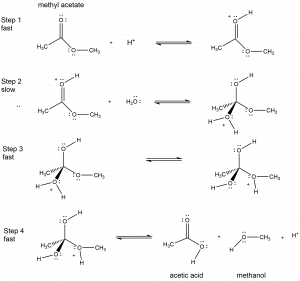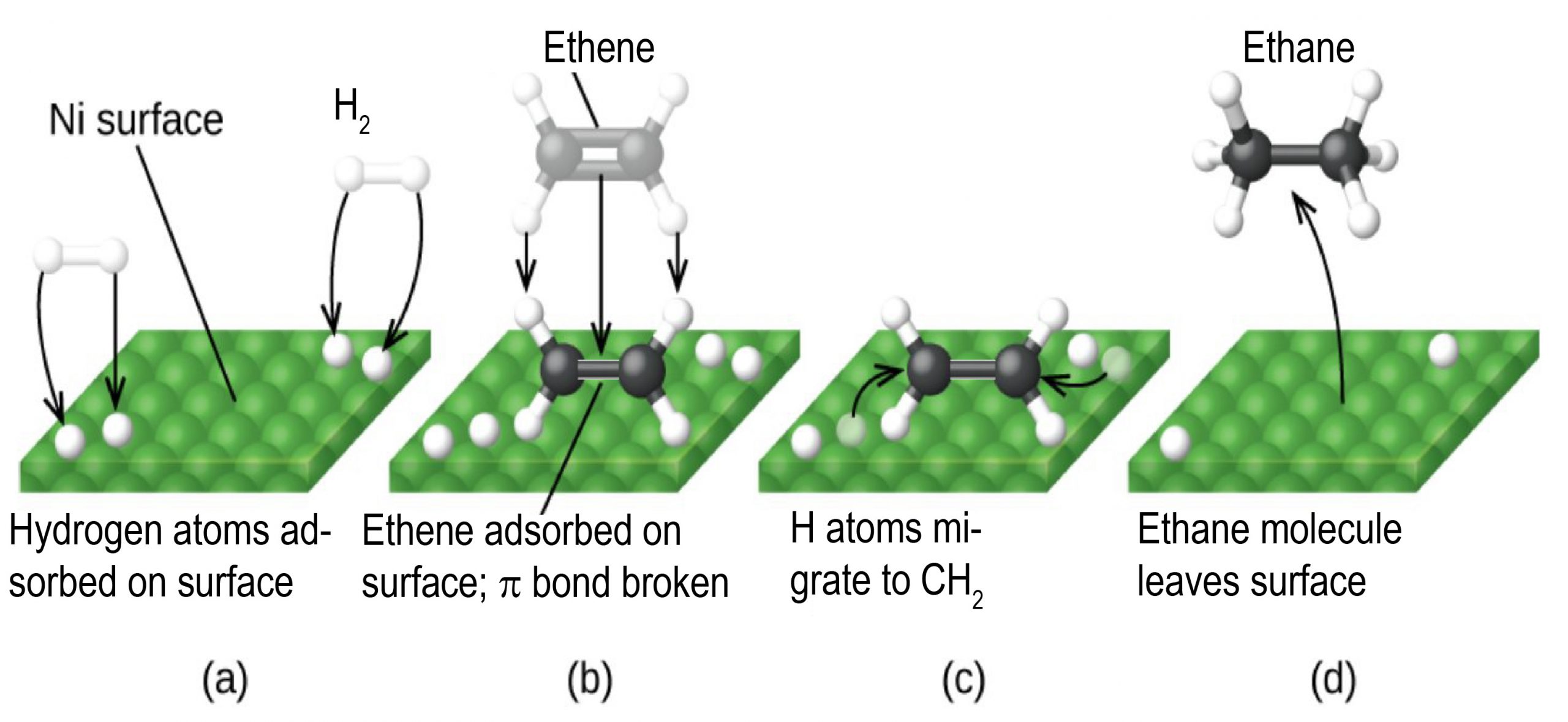Unit Three
Day 25: Homogeneous and Heterogeneous Catalysis
D25.1 Homogeneous Catalysis
Reactions that are facilitated by catalysts can be divided into two major classes: homogeneous catalysis and heterogeneous catalysis. A homogeneous catalyst is present in the same phase as the reactants. Gas-phase reactions and reactions in solution are homogeneous reactions and we have already discussed several examples where catalyst and reactants are all in the same phase. Here is one more.
In Section D13.5 we described condensation reactions and hydrolysis reactions that occur in aqueous solutions. (Hydrolysis is the reverse of a condensation that produces water as the small molecule.) We also mentioned that condensation and hydrolysis can be catalyzed by strong acids (that is, by H+ ions). This is a homogeneous catalytic reaction because reactants, products, and catalyst are all in aqueous solution.
An example of ester hydrolysis is the acid-catalyzed decomposition of methyl acetate to form acetic acid and methanol. The reaction mechanism is shown in Figure 1.

Activity 1: Analyzing a Reaction Mechanism
D25.2 Heterogeneous Catalysts
A heterogeneous catalyst is present in a different phase from the reactants. Such catalysts are usually solids, and often function by furnishing an active surface upon which one or more steps in the reaction can occur.
A heterogeneous catalytic reaction has at least four steps in its reaction mechanism:
- Adsorption of the reactant(s) onto the surface of the catalyst
- Activation of the adsorbed reactant(s)
- Reaction of the adsorbed reactant(s)
- Diffusion of the product(s) from the surface into the gas or liquid phase (desorption)
Any one of these steps may be slow and thus may serve as the rate determining step. But the overall rate of the reaction is still faster than it would be without the catalyst. Figure 1 illustrates the reaction of alkenes with hydrogen on a nickel catalyst.

The uncatalyzed C2H4(g) + H2(g) ⟶ C2H6(g) reaction would necessitate a transition state where the C=C π bond and the H-H σ bond are breaking while the C-H σ bonds form. Such a transition state is so high in energy that without a catalyst, H2 is considered as being unreactive towards alkenes under most conditions.
Nickel is a catalyst often used in the hydrogenation of polyunsaturated fats and oils to produce saturated fats and oils. Other significant industrial processes that involve the use of heterogeneous catalysts include the preparation of sulfuric acid, the preparation of ammonia, the oxidation of ammonia to nitric acid, and the synthesis of methanol. Heterogeneous catalysts are also used in the catalytic converters found on most gasoline-powered automobiles.
Exercise 1: Catalysis and Reaction Energy Diagram
Exercise 2: Catalytic Mechanisms
Podia Question
Platinum metal is a heterogeneous catalyst for this reaction:
2 NO(g) → N2(g) + O2(g)
The reaction rate varies with concentration of NO as shown in the graph.

Explain each of these observations. Include in your explanation an atomic-level description of NO molecules, the platinum surface, and how the two interact.
- The graph is linear with positive slope at low concentrations of NO.
- The graph is horizontal at high concentrations of NO.
Suggest an experiment that could be done to support or contradict your explanation of the horizontal graph. Describe the hypothesis you propose for what will happen in the experiment if your explanation is correct; also describe what experimental results would contradict your hypothesis.
Two days before the next whole-class session, this Podia question will become live on Podia, where you can submit your answer.

